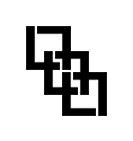Gestalt theory is a theory that explains how human perceive things not by recognizing first its parts but rather by looking at it as a whole. According to Paul Martin Lester (1995), in his book called, The sensual and perceptual theories of visual communication, said that “perception is a result o a combination of sensations and not of individual sensual elements”. Hence the saying, the whole is different from the sum of it parts.
What it means by that is that when we, human, perceive things we tend not to perceive parts of the object but instead we put it as a whole. This is because, according to Dr. Chris during his lecture on this topic, he said that the human brain is very lazy so it would take things that are just simple to make things easier. All of these are then combined and understood by using the five laws of gestalt which are, similarity, proximity, common fate, figure/ground (pragnanz) and closure.
 Proximity is the law that explains about the closeness of things in front of us and thus, we would group them together and make it as a whole. As stated by Lester (1995), I quote, “law of proximity states that brain more closely associates objects close to each other that it does two objects that are far apart.” (pp.54). For example the picture below, we would not perceive that picture harmoniously when it is apart from the other two, thus, our brain helps us in order to break tension by grouping it into one.
Proximity is the law that explains about the closeness of things in front of us and thus, we would group them together and make it as a whole. As stated by Lester (1995), I quote, “law of proximity states that brain more closely associates objects close to each other that it does two objects that are far apart.” (pp.54). For example the picture below, we would not perceive that picture harmoniously when it is apart from the other two, thus, our brain helps us in order to break tension by grouping it into one.The law of common fate is about the directional lines in an image or simply put, in an image. An easy example for this is using a fork. It has (usually) four prongs, when we look at the fork, we immediately sum it up as a fork but what if one of the fork is bended to any side? We will definitely feel or visualize it awkwardly due to the ‘no sense of direction’. Armag˘an Emre C¸ akır (2009), says that “Units that function in the same manner or move in the same direction are perceived as a group.”
The last but not least, the law of closure. According to Armag˘an Emre C¸ akır (2009), “Closure is our tendency to perceive objects as complete wholes and to fill in visual elements that are not part of the stimulus”. We do not perceive an image per one instead we look at it as a whole. It doesn’t matter if there are some mistakes was done on an image as long as we have the idea and familiarity of it, we, thus, gather the information together and group it as one. For example, some lines are missing but we still perceive these two images as a circle and a square.
Schema Theory
This theory generally explains about how we create our knowledge and used. According to Tracey and Morrow (2006), in their book called Lenses on Reading, “..people organize everything they know into schemas, or knowledge structures. People have schemas for everything in their lives including people, places, things, language, processes, and skills”(pp.51). In relation to making an image, schema is used as a tool to show people a certain objects and make them try and relate to it by using their knowledge on that particular. That also enables them to elaborate their knowledge along the way. A simple example would be, if Tiger Woods and I have to compete for getting laid then I’d lost instantly because he was married and had an affair. Means he has more experience than me. Haha!
Schema has a frame-system that can be divided in two; top level which represents what is true and visible for us and low level that is like a slot that needs to be filled or something that can change. For example, top level information for a restaurant is door, ceiling, aircond, plates and etc. Lower level then can be about the door of the restaurant is a sliding door or the aircond is centralized.
 Schema also can be divided into two types. These types are incongruent schema and congruent schema. Incongruent schema is simply put as a schema that has not yet ready to be accepted. In other words, weird. For example.
Schema also can be divided into two types. These types are incongruent schema and congruent schema. Incongruent schema is simply put as a schema that has not yet ready to be accepted. In other words, weird. For example. Congruent schema has information that is acceptable to people due to its familiarity that sends positive impact which makes it has low level of cognitive processes.
References:
Lester, P. M. (1995). The sensual and perceptual theories of visual communication. Visual communication: Images with Messages (pp.52-58) California: Wadsworth Publishing.
Tracey, D. H. and Morrow, L. M. (2006). Schema theory. An Introduction to Theories and Models (pp.51-54). New York: Guildford Press.
C¸ akır, A. E. (2009). International Studies Perspectives. (pp.1-5) Marmara University: Blackwell Publishing Ltd.





No comments:
Post a Comment